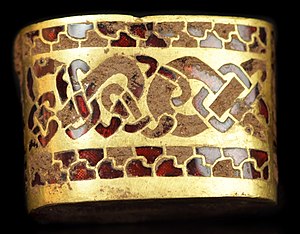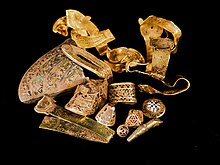Staffordshire Hoard

The Staffordshire Hoard is the largest hoard of Anglo-Saxon gold yet found. Discovered in a field in Staffordshire in England on 5 July 2009, it consists of over 1,500 items that are nearly all martial in character. The artefacts have tentatively been dated to the 7th or 8th centuries A.D., placing the origin of the items in the time of the Kingdom of Mercia. Experts have theorised about the purpose of the deposit, and whether those who made it were Christians or pagans.
Discovery
Terry Herbert of Burntwood in Staffordshire, a 55-year-old who had been practising amateur metal detection for eighteen years, uncovered a few scraps of gold on a farm owned by Fred Johnson near Lichfield, Staffordshire, England, in July 2009.[1][2] The hoard was reported to Duncan Slarke, the local officer of the Portable Antiquities Scheme, and on 24 September 2009 was declared treasure by the South Staffordshire coroner Andrew Haigh, meaning it belongs to The Crown.[3] The hoard is believed to be worth in excess of £1 million, which will be paid as a reward to the landowner and Herbert.[4]
Following the discovery, an archaeological excavation was undertaken by Staffordshire County Council with the assistance of Birmingham Archaeology , an archaeological contractual unit associated with the University of Birmingham. Because of the importance of the find, the site of the hoard has been kept secret, though no traces of any graves, buildings, or other structures have been found.[4] The discovery was announced publicly on 24 September 2009, after completion of the coroner's inquest, with the site being reported only as "near Burntwood".[5]
The objects are currently placed in the Birmingham Museum & Art Gallery, where they are on display until 13 October.[6] There is currently much discussion, with all partners, as to the future transfer of the hoard. As of 24 September 2009, 1,381 objects had been recovered, of which 864 have a mass of less than 3 grams, 507 less than 1 gram. X-rays of unexamined lumps of earth suggest that there are more to be revealed. Early analysis established that the hoard was not associated with a burial.[7]
The hoard consists of up to 5 kg (11 lb) of gold and 1.3 kg (2.9 lb) of silver,[8] and is the largest treasure of Anglo-Saxon gold and silver objects discovered to date, eclipsing, at least in quantity, the 1.5 kg (3.3 lb) hoard found in the Sutton Hoo ship burial in 1939.[4]
Contents

The hoard consists of over 1,500 items.[8] The contents include finely worked silver and gold sword decorations removed from weaponry, including 66 gold sword hilt collars and many gold hilt plates, some with inlays[7] of cloisonné garnet in zoomorphic designs (see lead picture).[9] The Staffordshire Hoard official press statement notes that the only items in the hoard that are obviously non-martial are two (or possibly three) crosses. The largest of the three crosses is missing some decorative settings (yet some are present but detached) but otherwise remains intact, and it may have been an altar or processional cross. Yet the cross is folded; either prior to burial "to make it fit into a small space" or as a sign that the burial deposit was made by pagans. On the other hand, the statement notes, "Christians were also quite capable of despoiling each other's shrines."[8]
One of the objects is a small strip of gold inscribed on both sides with a well known Latin quotation[note 1] from the Old Testament: SURGE DNE DISEPENTUR INIMICI TUI ET FUGENT QUI ODERUNT TE A FACIE TUA ("Surge Domine et dissipentur inimici tui et fugiant qui oderunt te a facie tua"), which translates as: "Rise up, Lord; may Your enemies be scattered and those who hate You be driven from Your face."[8]
Michelle Brown, Professor of Medieval Manuscripts Studies in London, believes that, based on the use of uncial letter forms, the style of lettering used implies a date of 7th or early 8th century, whereas Professor Elisabeth Okasha of University College Cork, an expert on early medieval inscriptions, has identified traits in the insular majuscule script that are similar to later inscriptions datable to the 8th or early 9th century.[8][10]
Most of the other treasures unearthed in the hoard appear to be military-related and the strip may have been fastened originally to a shield or a sword belt.[11] There are no domestic objects, such as vessels or eating utensils, or feminine jewellery, which are the more common Anglo-Saxon gold finds, and reportedly, the contents "show every sign of being carefully selected".[7]
Purpose
Michael Lewis, the deputy head of the Portable Antiquities Scheme at the British Museum, notes that there are two possible reasons behind the burial of the hoard: either it was a votive deposit (an offering to the gods) or "a treasure chest that got lost, or they couldn't come back for it." Lewis comments that "from my 21st-century perspective, I find it bewildering that someone could shove so much metalwork into the ground as an offering. That seems like overkill."[12]
Kevin Leahy, National Finds Adviser of the Portable Antiquities Scheme, says that the quantity of gold is extremely impressive and that, "more importantly, the craftsmanship is consummate, this was the very best that the Anglo-Saxon metalworkers could do, and they were very good." Leahy says that the finds must originate from the highest possible levels of the Saxon elite. Leahy comments that the find does not consist simply of loot, pointing out that swords were specifically singled out, that most of the gold and silver items appear to have been intentionally removed from the objects they were previously attached to, and that, if the depositer was just after the gold, fittings from sword belts would have been discovered. Leahy theorizes that the intention behind the removal of the gold fittings may have been to depersonalise the objects; removing the identity of the previous owners. The blades may have then been reused.[13]
Leahy observes that the hoard appears to be a collection of trophies, yet that it is impossible to say whether the hoard consists of the spoils of a single battle or is the result of a long series of successful military engagements. Leahy says that the reason for the burial is unknown, and theorizes that the deposit "may have been tribute to pagan gods or concealed in the face of a perceived, but all too real, threat, which led to it not being recovered." Leahy notes that further work will result in a better understanding of how the hoard came to be buried.[13] Leahy points out that the find includes dozens of pommel caps—decorative attachments to sword handles—and that Beowulf contains a reference to warriors stripping the pommels of their enemies' swords.[14]
Historical background
The area of Staffordshire was part of the kingdom of Mercia in the 7th and 8th centuries, an era for which contemporary written texts are scant, aside from Bede, whose Historia ecclesiastica gentis Anglorum, finished in 731, was written from the Christian perspective of a monk in Northumbria; Bede, however, appears to have had no contacts in Mercia.[15] Archaeology and written sources are used to gather information regarding the missing cultural history.
Michael Lewis opines that attempting to link the hoard to a particular individual is not realistic. He notes that, during the period from which the hoard dates, some rulers from Mercia are well known, including Penda and Offa. Penda ruled slightly before the period of the hoard, and "Offa is right at the end, so it has to be someone in the middle." Moreover, the historical record for the period shows a dependency on Bede, who wrote from a Christian perspective, yet the Mercians at the time were likely pagans, and therefore "could have been overlooked by Bede even though they might have been important, because he wasn't interested in them — for whatever reason." Lewis comments that the hoard will assist in looking back at literary sources and historical figures with more scrutiny.[12]
Significance
The hoard has been described by Leslie Webster, former keeper of the department of prehistory at the British Museum, as "absolutely the metalwork equivalent of finding a new Lindisfarne Gospels or Book of Kells" and stated further that "this is going to alter our perceptions of Anglo-Saxon England as radically, if not more so, as the Sutton Hoo discoveries".[16]
Bland said: "It is a fantastically important discovery. It is assumed that the items were buried by their owners at a time of danger with the intention of later coming back and recovering them." He commented the hoard was thought to date back to between AD 675 and 725, during the time of the kingdom of Mercia.[dubious – discuss][5]
See also
- History of Anglo-Saxon England
- Mildenhall Treasure — Roman Silver Hoard discovered in a field
- Our Top Ten Treasures — 2003 special episode of BBC Television series Meet the Ancestors, which profiles the 10 most important treasures ever unearthed in Britain to that point
- Sutton Hoo — Anglo Saxon cemetery, and site of the famous Ship Burial discovery
- Vale of York Hoard — 10th century Viking hoard of over 617 silver coins and other items
Notes
- ^ This phrase, used in the liturgy for consecration of churches, is from Numbers 10:35, and appears in Psalm 67:2 in the form "exsurgat Deus et dissipentur inimici eius et fugiant qui oderunt eum a facie eius". The apparent mistakes are due to the engraver's error and common Medieval spelling variants.[7]
References
- ^ "Huge Anglo-Saxon gold hoard found". News.bbc.co.uk. Retrieved 2009-09-24.
- ^ "Largest Anglo-Saxon hoard in history discovered". Daily Telegraph. Retrieved 2009-09-26.
- ^ "Leader Philip Atkins vows to do justice to the unique Staffordshire Hoard". Staffordshire County Council. Retrieved 2009-09-25.
- ^ a b c Kennedy, Maev. "Largest ever hoard of Anglo-Saxon gold found in Staffordshire". Guardian.co.uk. Retrieved 2009-09-24.
- ^ a b "Anglo-Saxon gold: largest ever hoard officially declared treasure". Telegraph.co.uk. Retrieved 2009-09-24. "Mr Bland said the hoard — thought to date back to between 675 and 725AD — was unearthed in what was once the Kingdom of Mercia."
- ^ "Crowds visit Anglo-Saxon hoard". News.bbc.co.uk. Retrieved 2009-09-26.
- ^ a b c d "The Staffordshire Hoard: Discovery and Initial Assessment" (PDF). Portable Antiquities Scheme. Retrieved 2009-09-24.
- ^ a b c d e "The Staffordshire Hoard: Press statement". Cite error: The named reference "ca" was defined multiple times with different content (see the help page).
- ^ "Catalogue of the objects". Portable Antiquities Scheme. p. 82. Retrieved 2009-09-24.
449 ... Gold ... Sword Hilt Collar
- ^ "UCC Expert Called in by British Museum". University College Cork. Retrieved 2009-09-25.
- ^ Satter, Raphael G. "Largest hoard of Anglo-Saxon treasure found in UK". Associated Press. Retrieved 2009-09-24.
- ^ a b Lewis, Michael. "Hoard Shines Light on Dark Ages". News.bbc.co.uk. Retrieved 2009-09-25.
- ^ a b "The Staffordshire Hoard: Kevin Leahy's Interpretation". Retrieved 2009-09-26.
- ^ Raphael G. Satter, "Treasures Shed Light on Dark Ages", (Washington, D.C.) Express, September 25, 2009, p. 7.
- ^ Barbara Yorke, "The Origins of Mercia" in M. P. Brown and C. A. Farr, Mercia: an Anglo-Saxon kingdom in Europe, 2005:100.
- ^ "The Staffordshire Hoard: Comments sent to us".
External links
